Pad Thai with Shrimp and Tofu
Pad Thai is an iconic Thai Noodle dish with sweet, sour, and salty flavors. I show how to make your own sauce easily to create this dish at home.
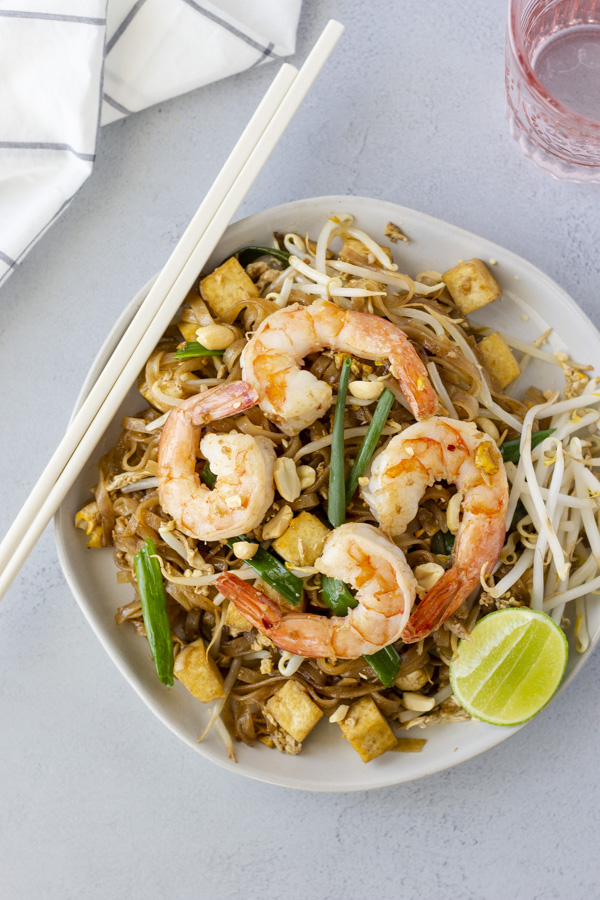
Usually when someone is trying Thai food for the first time, they order Pad Thai. It’s a safe choice, you really can’t go wrong with stir-fried rice noodles. Pad Thai has a popular trifecta of flavors, sweet, salty, and a little sour from the tamarind (which is a key ingredient in the sauce).
Pad Thai can be intimidating to recreate at home, but I will list steps below along with a full YouTube Video at the end of this post. I highly recommend watching the video before making this dish.
How to Make Pad Thai Sauce
Tamarind is essential for a good Pad Thai Sauce. There really isn’t a comparable substitute for tamarind, but I’ve adjusted this recipe to using Tamarind paste or puree, which I was able to get at Sprouts or I’ve listed a comparable brand on Amazon.
The original recipe uses Tamarind Concentrate, which is used in Thai cooking. This version contains water and is more mild than the tamarind paste. You’ll see in the recipe card if using tamarind paste use 1 Tbsp, and if using concentrate you’ll need 2 Tbsp.
Fish Sauce will add saltiness and umami to the sauce. I used 2 tsp, but you can start off with 1 tsp and add more if needed. Fish sauce is sold at most grocery stores, and online. You can sub soy sauce, but it’s going to give a different taste.
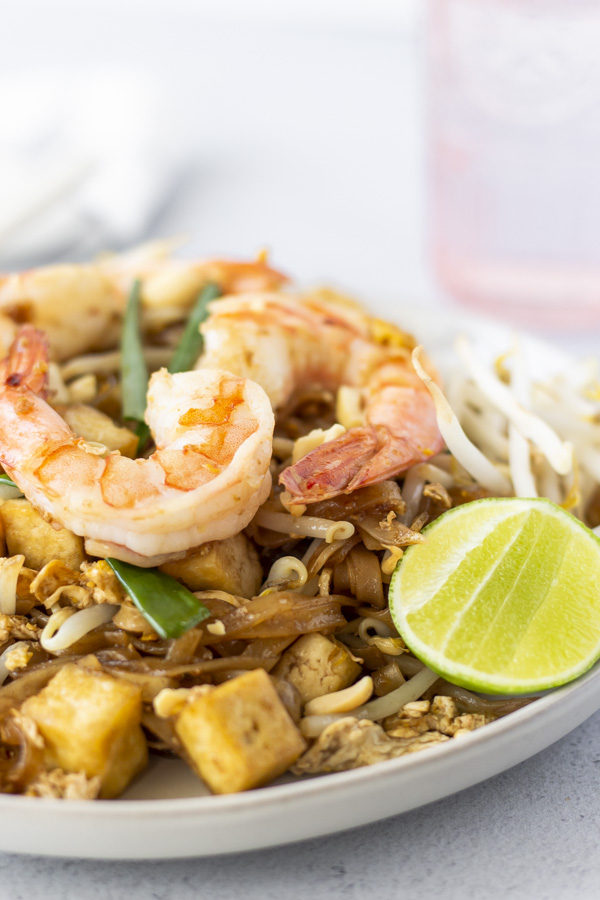
Coconut Sugar brings sweetness to the sauce and traditionally Thai cooking uses Palm discs. You can find hard palm sugar at Asian markets, but I always have coconut palm sugar on hand, and I feel the taste is pretty similar. Plus coconut sugar can be found at most stores these days.
What kind of Rice Noodles to Use
Fresh vs. Dried Rice Stick Noodles- You can find refrigerated fresh rice stick noodles at most Asian grocery stores. I prefer to use the fresh noodles since they don’t require any soaking and absorb the sauce better.
However, the dried rice stick noodles are more common in local grocery stores. If you are using the dried one, be sure to soak them according to the package directions.
You can soak them longer, just keep in mind that the longer they soak, the less chew they will have to them. The noodles will also be more prone to breaking when cooking.
I recommend only cooking 1 portion at a time, which in this recipe equates to 4 oz of rice noodles. I use my handy kitchen scale to weigh out the portions. If you don’t have one then try to divide the package evenly. The package I used was 16 oz of Fresh Rice noodles, so divide evenly into 4 portions.
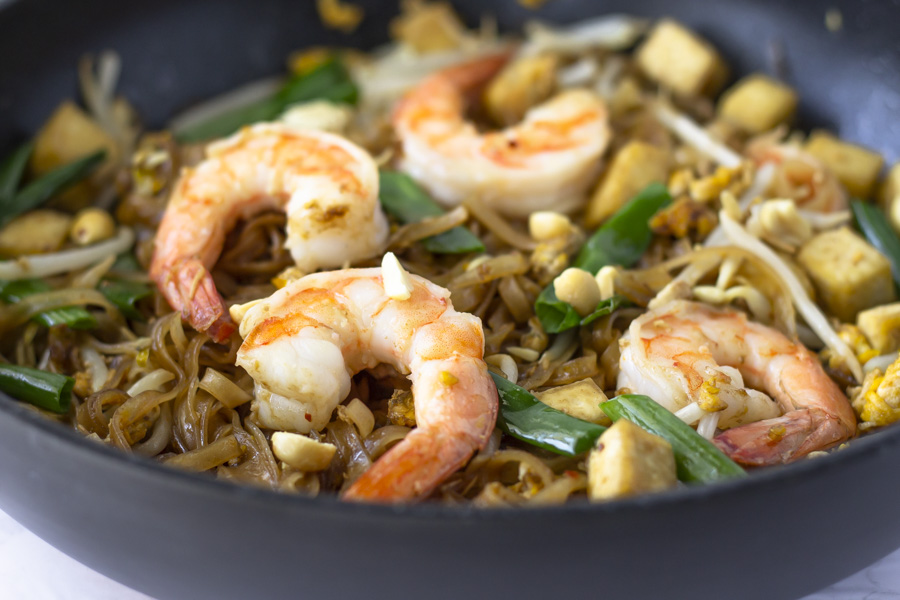
How to Cook the Protein
For this recipe, I’m using Fried Tofu Cubes and Shrimp. You can make this meatless by omitting the shrimp and use extra tofu.
Use extra firm tofu, remove from packaging, and place between paper towels or a kitchen towel to drain out all the water. Leave it wrapped on a plate for 20 minutes.
Use 1/4 of the block of tofu and slice into small blocks. To fry the tofu, use a small non-stick skillet and cover the bottom with oil, I used vegetable oil.
Fry each side until golden, remove to drain on a paper towel and season with salt.
Additionally you can swap out the tofu and shrimp for sliced chicken, pork, or even beef. When cooking the meat, add a little bit of soy sauce prior to cooking to give the protein some flavor. Cook the chicken, pork, or beef, until done and remove from the pan. Then proceed with the recipe.
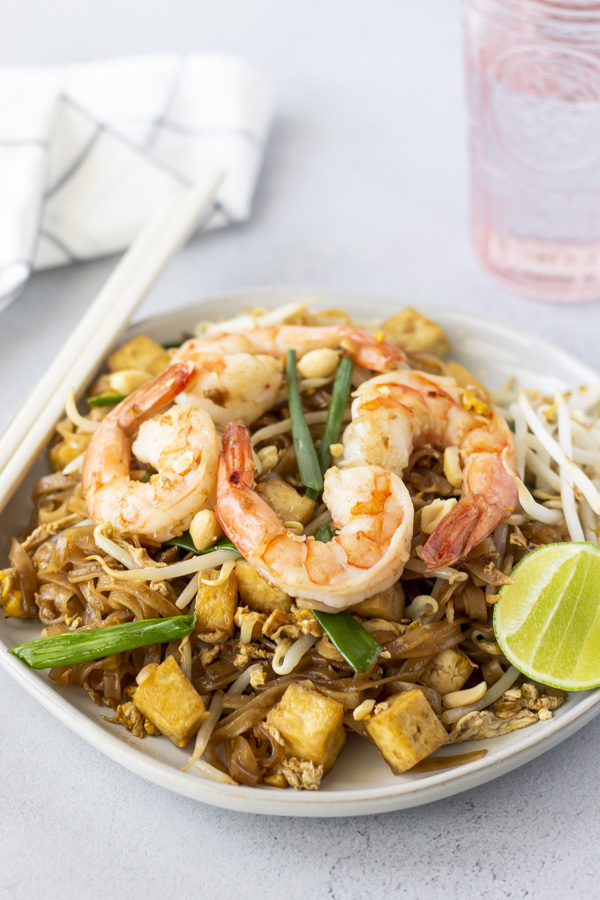
How to Cook Pad Thai
Pad Thai is best served immediately after cooking. You can prep all the ingredients and start cooking once you are ready to eat. Active cooking time is about 5 minutes.
I’m using a 10” non stick skillet to cook the Pad Thai. If you have a wok then you can use that, but I got great results in a non-stick skillet.
Cook the protein and tofu first, then leave 2 Tbsp of oil in the skillet. I know this may seem like a lot of oil, but it’s needed to prevent the noodles from clumping together.
The heat needs to be at medium high. Add Garlic, then the noodles, Pad Thai sauce, and move everything around quickly to incorporate.
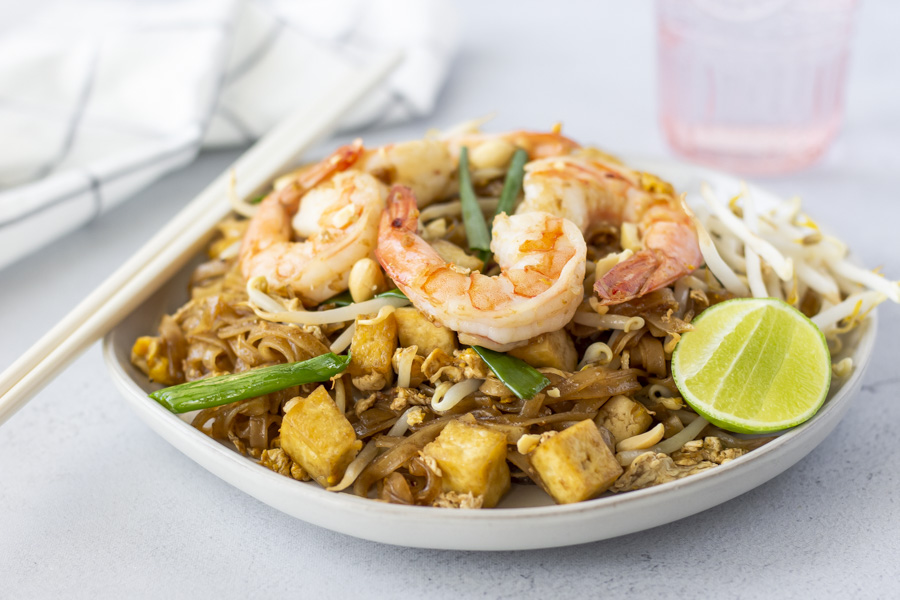
If you are using Tamarind puree/paste, the noodles will look dark. The taste will still be good.
At this point you want to taste the noodles and see if they are still hard. If so add a splash of water to help soften them.
Push noodles to the side and add in the egg. Break the yolk and allow it to set then place noodles on top to cook the egg.
Place the shrimp, tofu, half of the bean sprouts, half of the green onions, and half of the crushed peanuts into the skillet. Use tongs and toss with the noodles.
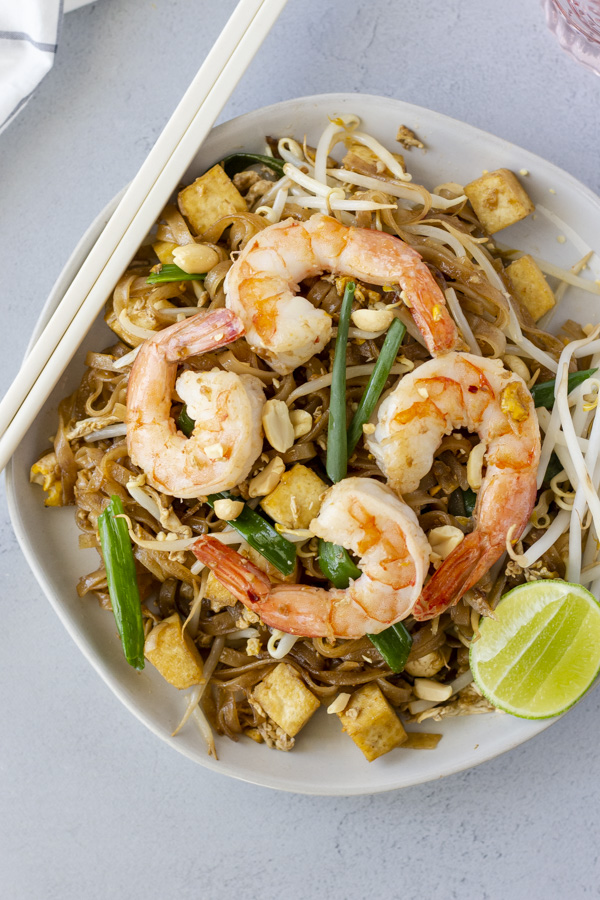
Go ahead and taste for seasoning and adjust if needed.
Plate and serve with remaining bean sprouts, green onions, peanuts, and a slice of lime. In Thailand they serve Pad Thai with extra condiments of dried chili flakes, granulated sugar, and fish sauce, but this is optional.
Now enjoy your restaurant quality Pad Thai at Home! If you want to tackle another popular Thai noodle dish, try my Pad See Ewe.
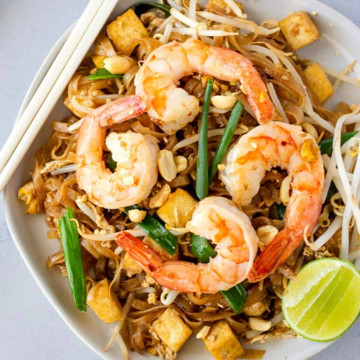
Pad Thai with Shrimp and Tofu
Want to Save This Recipe?
Enter your email & I’ll send it to your inbox. Plus, get great new recipes from me every week!
By submitting this form, you consent to receive emails from Thai Caliente
Ingredients
Pad Thai Sauce:
- ¼ Cup Warm Water
- 2 tablespoon Palm Sugar
- 2 tablespoon Tamarind Concentrate
- 1-2 teaspoon Fish Sauce (Depending on how salty you want it)
Pad Thai (Makes 1 Large Serving):
- 2 tablespoon Vegetable Oil Can use Vegetable, Avocado, grape seed, or canola oil. Don't use olive oil, the taste is too strong.
- 4 Shrimp
- 1 Large Clove Garlic minced
- 4 ounces Rice Stick Noodle Softened according to package directions
- Pad Thai Sauce See above
- 1 Egg
- ½ Cup Fried Tofu Cubes
- ½ Cup Bean Sprouts
- ¼ Cup Sliced Green Onions Or if you can find Garlic Chives
- 2 tablespoon Crushed Roasted Peanuts
Garnishes:
- Sliced Lime, Chili Pepper Flakes, Sugar, Fish Sauce
Instructions
Pad Thai Sauce:
- Add coconut sugar to warm water and mix to dissolve. Then add tamarind (either puree, paste, or concentrate). Stir to dissolve, then add fish sauce. I used 2 tsp, but if you want it less salty start with 1 tsp. Taste and adjust if needed.
Pad Thai:
- If using dried rice stick noodles, soak in room temperature water according to package directions. If you are using fresh noodles then portion out 4 oz from the bag.
- Use extra firm tofu, remove from packaging, and place between paper towels or a kitchen towel to drain out the water. Leave wrapped on the plate for 20 minutes. Use ¼ of the block of tofu and slice into small cubes.
- To fry the tofu, use a non-stick skillet and cover the bottom with oil. Fry each side until golden, remove to drain on a paper towel and season with salt.
- Pad Thai is best served immediately after cooking. You can prep all the ingredients up until now, then start cooking once you are ready to eat. Active cooking time is about 5 minutes.
- Heat wok over medium heat with a little oil, add shrimp and cook until pink, remove shrimp and set aside.
- Turn heat up to medium high. Add remaining oil, minced garlic, noodles, Pad Thai sauce, and move everything around quickly to incorporate. (If you are using Tamarind puree/paste, the noodles will look dark. The taste will still be good.)
- At this point you want to taste the noodles and see if they are still hard. If so add a splash of water to help soften them.
- Push noodles to the side and add in the egg. Break the yolk and allow it to set then place noodles on top to cook the egg. Place the shrimp, tofu, half of the bean sprouts, half of the green onions, and half of the crushed peanuts into the skillet. Use tongs and toss with the noodles. Go ahead and taste for seasoning and adjust if needed.
- Plate and serve with remaining bean sprouts, green onions, peanuts, and a slice of lime. In Thailand they serve Pad Thai with extra condiments of dried chili flakes, granulated sugar, and fish sauce, but this is optional.
Video
Notes
Nutrition
Nutritional information is provided as an estimate only and depends on ingredients and amounts used. Thai Caliente makes no guarantees to the accuracy of this information.

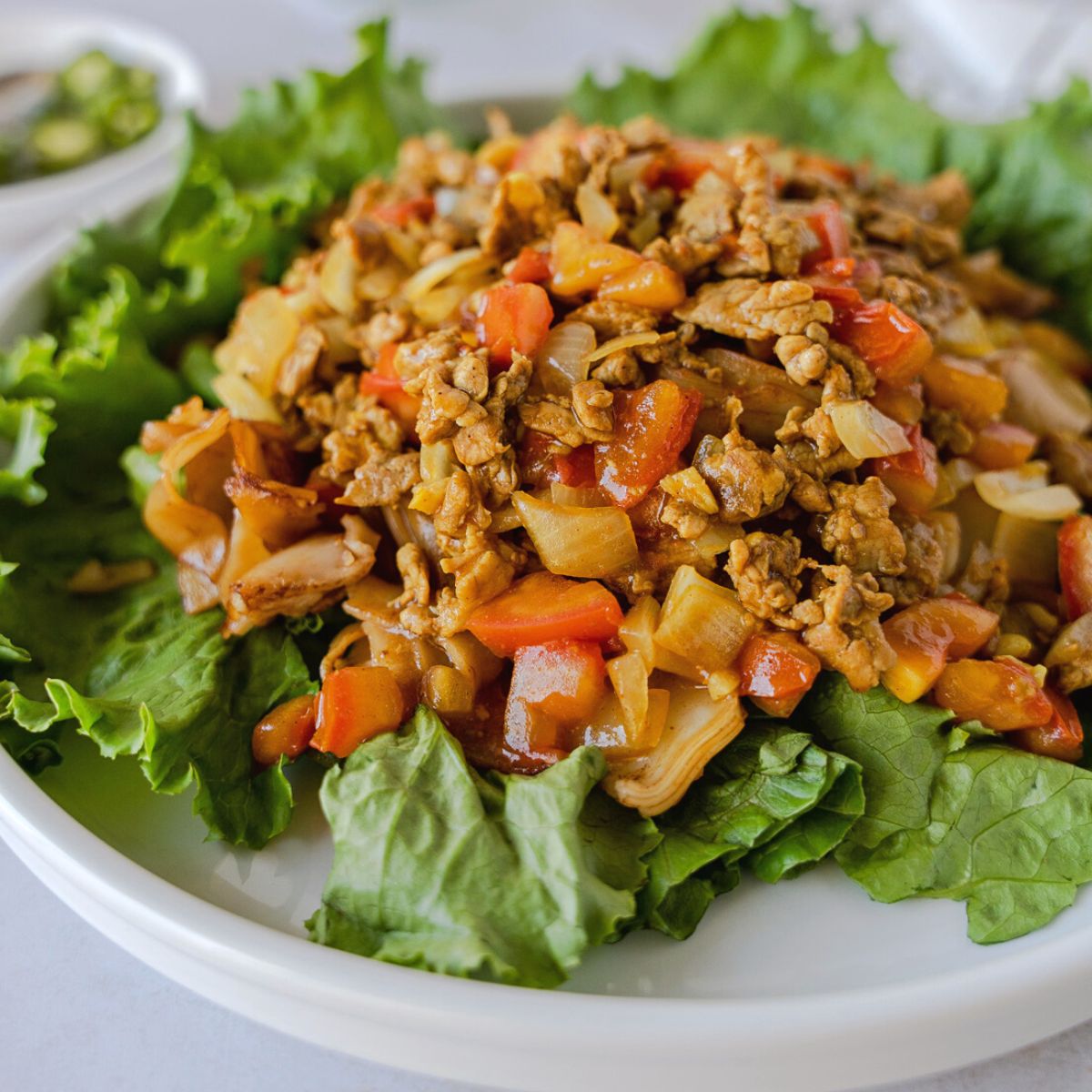
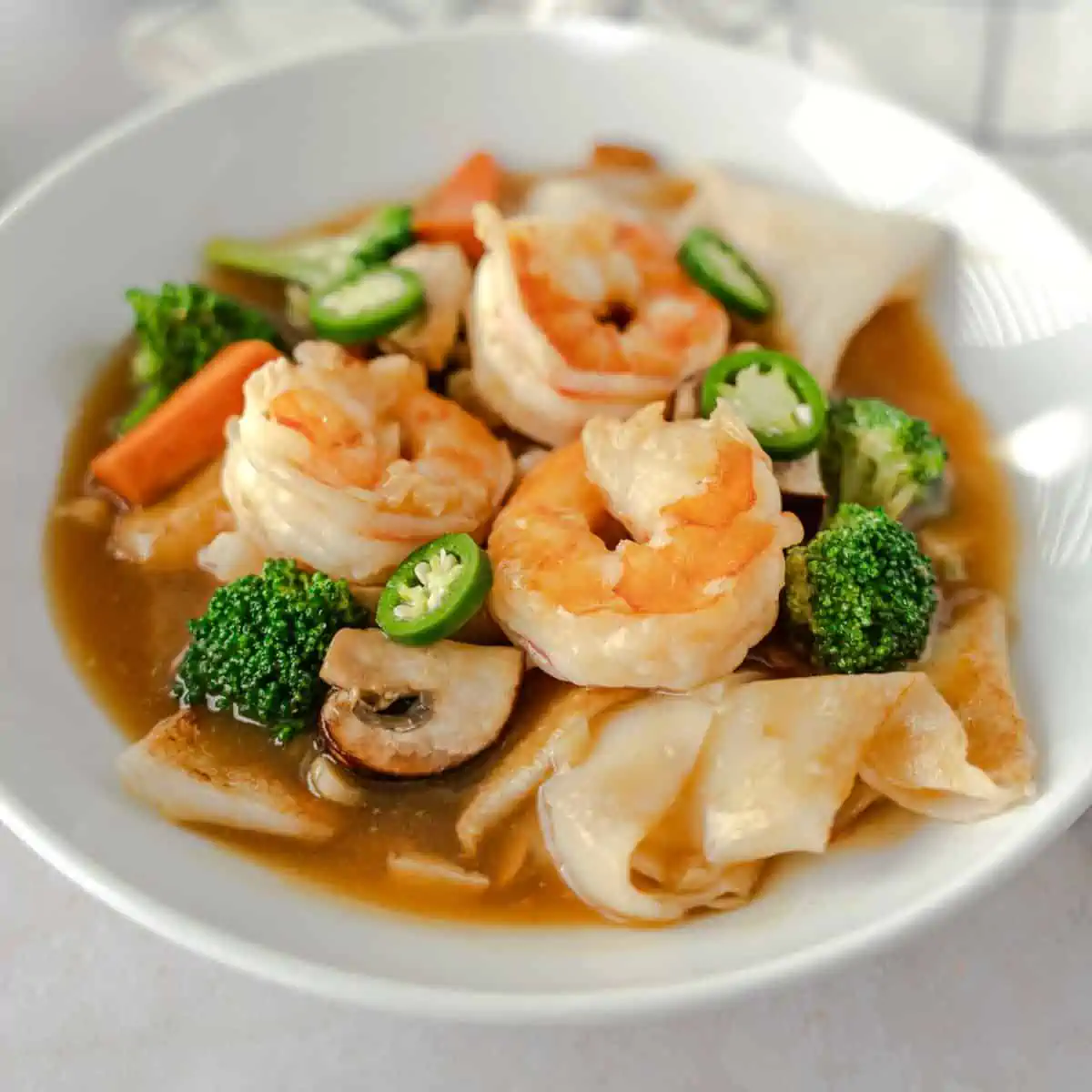
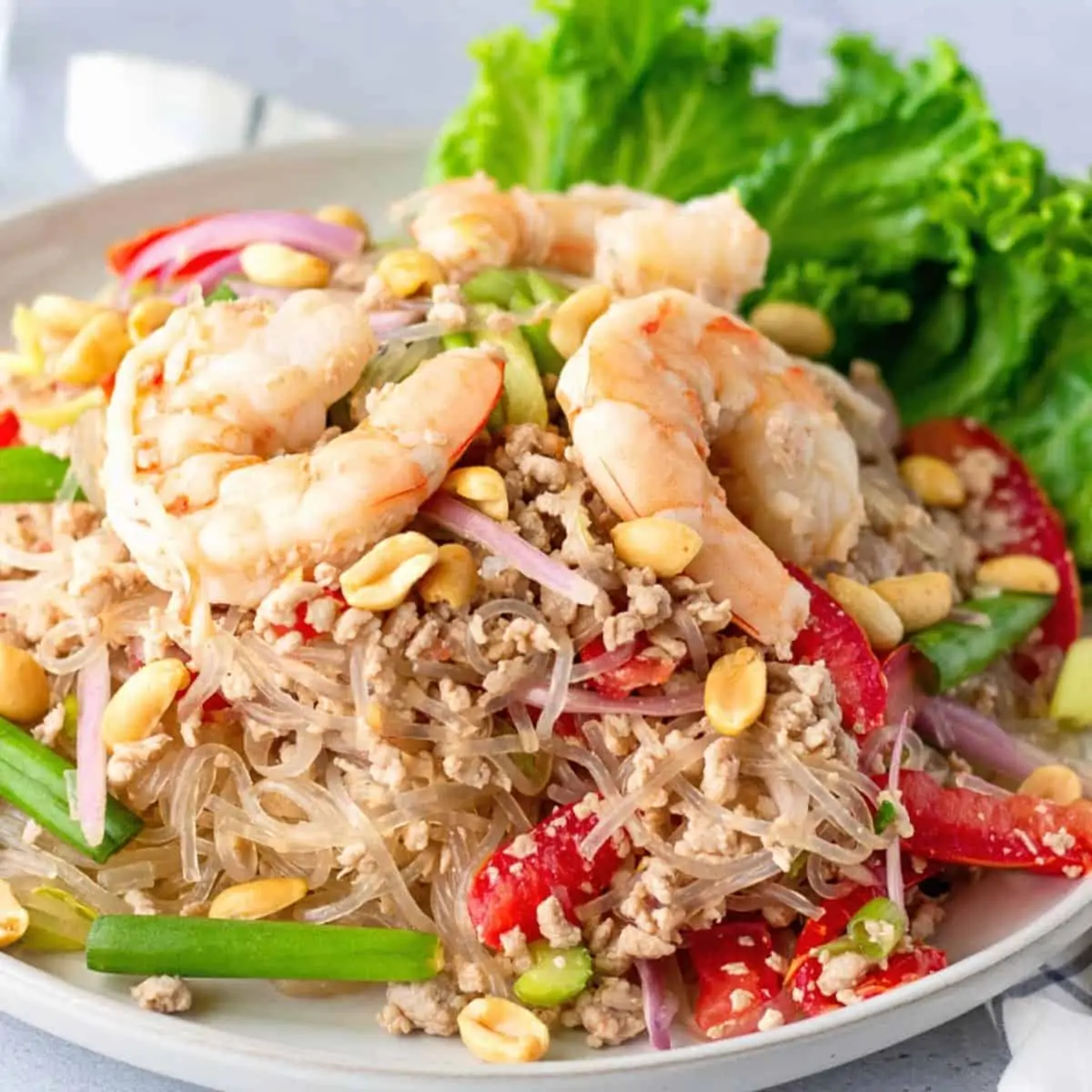
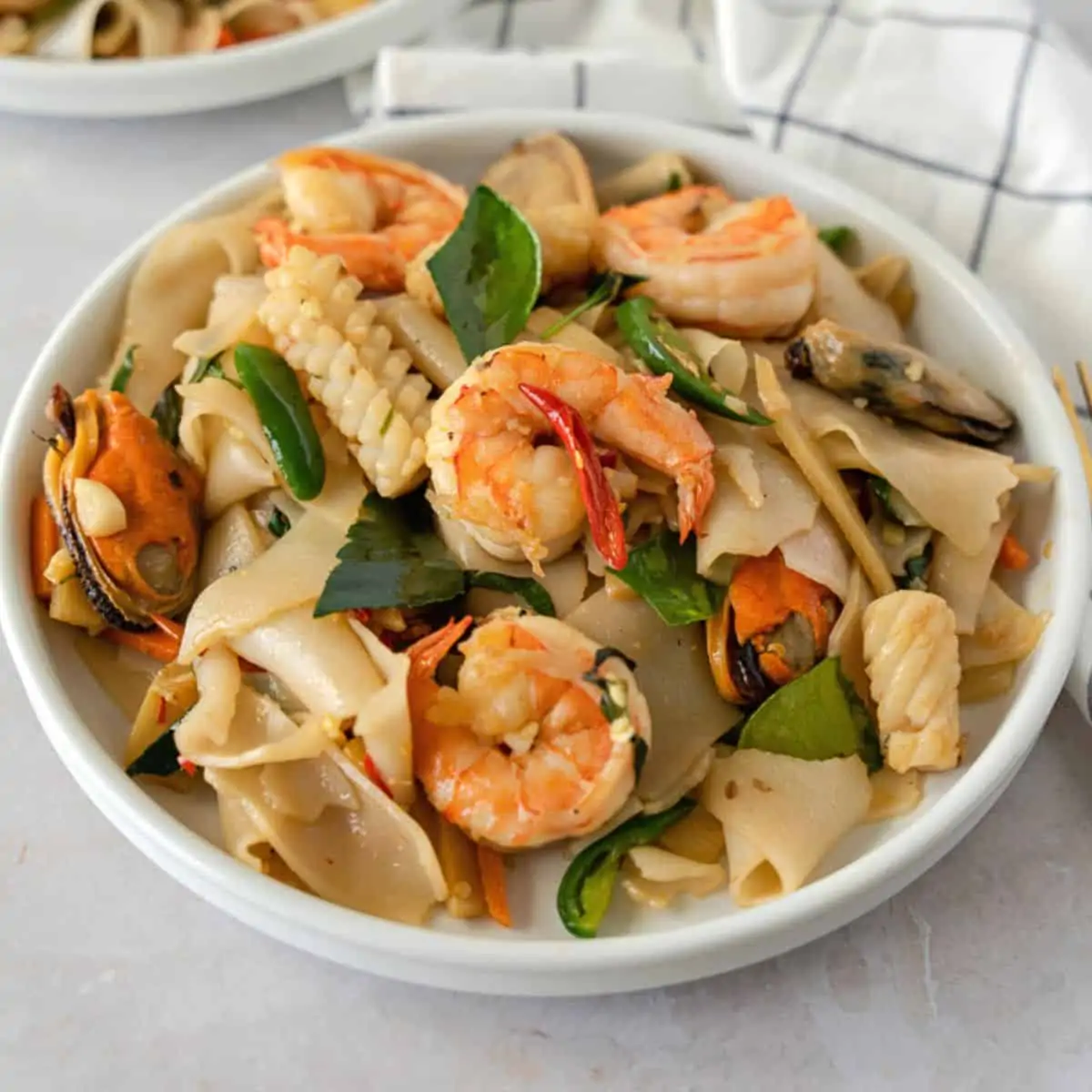
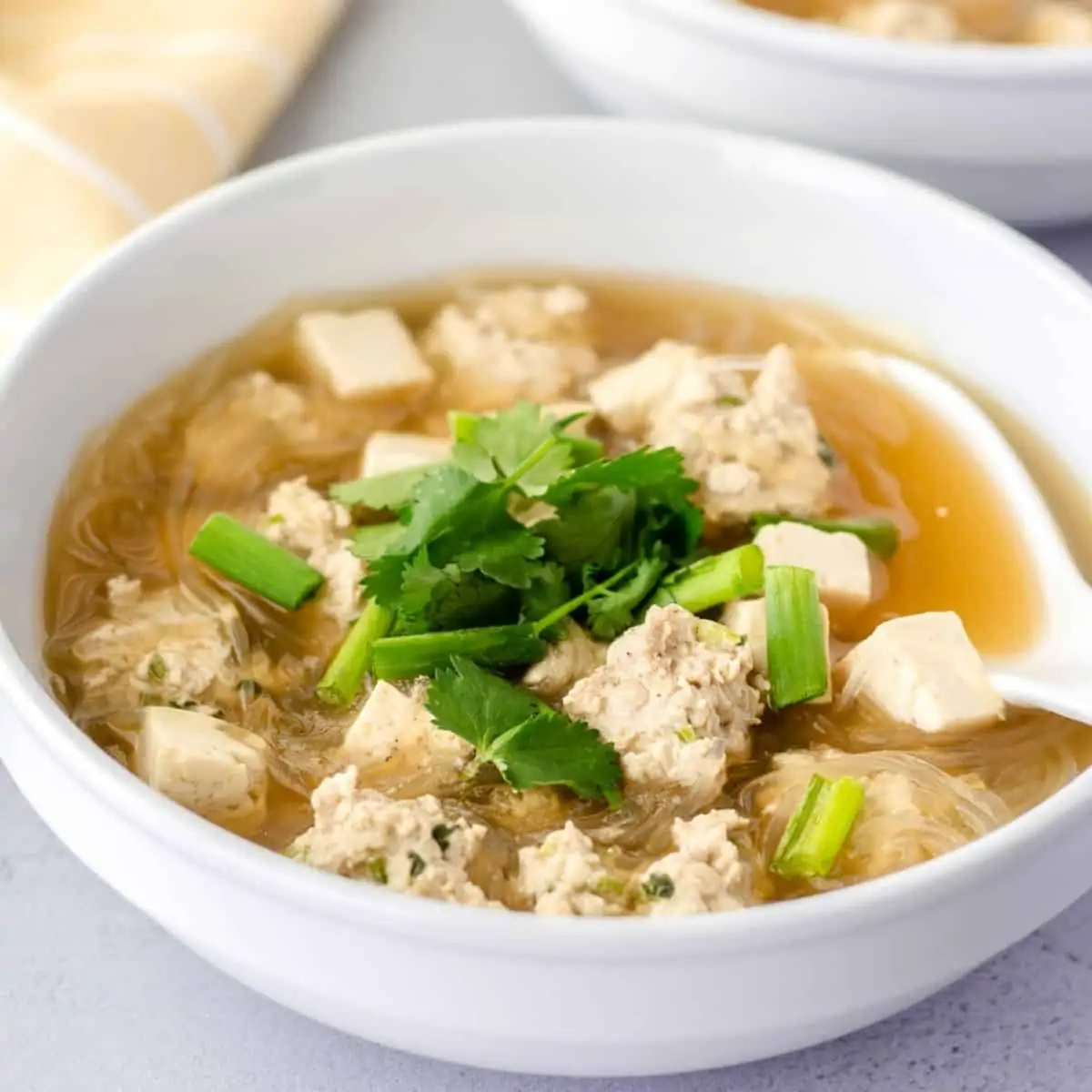
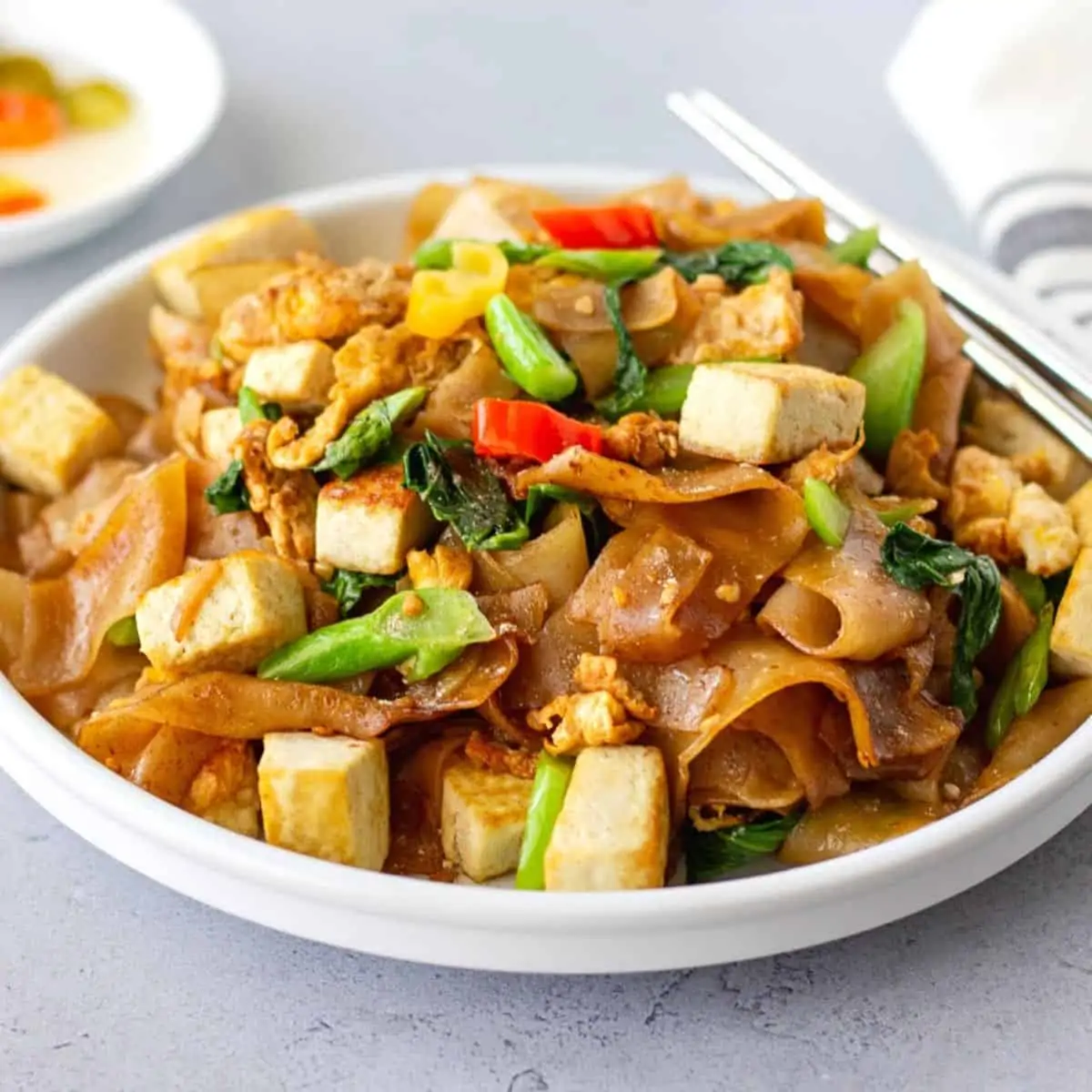
Looks delicious! Pad Thai is one of my favorites!
Thanks Marci! Yes, its such a delicious and comforting dish!